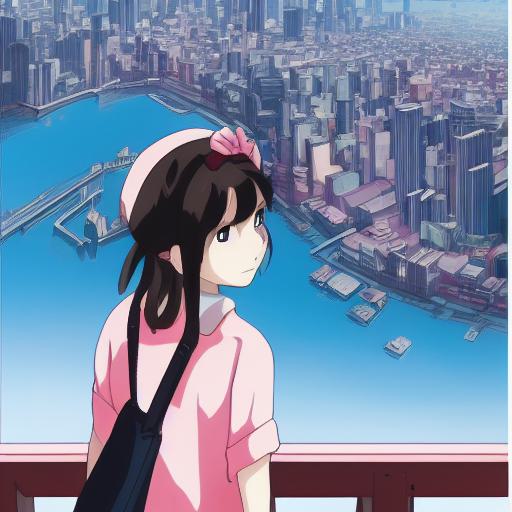How to write this prompt?
Here’s a breakdown of the different elements in the AI image prompt and how they influence the image being generated:
- Setting: The prompt describes the cityscape of Tokyo as vibrant and portrays the school girl standing on a rooftop. This sets the stage for the image and influences the overall environment and backdrop.
- Style: The prompt mentions an analog photo style, which suggests a vintage or retro look. This influences the image to have characteristics reminiscent of old photographs, such as specific color tones, grain, or other effects associated with analog photography.
- School Girl: The prompt emphasizes the presence of a school girl as the main subject. The choice of a school girl as the character influences the image to include a young, innocent, and curious figure, which adds a sense of wonder and amazement to the scene.
- Uniform Color: The prompt specifies that the school girl’s uniform is crimson, adding drama and visual impact to the image. This influences the generated image to have a striking color contrast and possibly evoke certain emotions associated with the color red.
- City Scale: The prompt mentions an extreme long-shot that captures the scale of the city. This influences the image to have a wide-angle perspective, showing a vast cityscape and emphasizing the grandeur and immensity of Tokyo.
- Fisheye Lens: The prompt suggests the use of a fisheye lens, which creates a distorted and surreal atmosphere. This influences the generated image to have a unique perspective with exaggerated curves and a sense of bending or stretching in the visuals.
- Atmosphere: The prompt describes the use of volumetric fog and an overglaze effect, which contribute to a dreamlike and ethereal atmosphere. This influences the image to have a hazy, mystical quality, evoking a sense of enchantment and mystery.
- Accent Lighting: The prompt mentions accent lighting illuminating the school girl’s face. This influences the image to have specific lighting effects that highlight and draw attention to the school girl’s facial features, creating a focal point within the composition.
By combining these various elements and providing specific details, the prompt guides the AI model to generate an image that aligns with the described scene, style, atmosphere, and character, resulting in an enchanting anime portrait with the specified characteristics.
What is an analog photo style?
An analog photo style refers to a visual aesthetic that resembles the characteristics of traditional film photography. It often includes features such as grain, color tones, light leaks, and other imperfections commonly associated with older cameras and film processing techniques. This style aims to recreate the nostalgic and vintage look of photographs taken with analog equipment.
How to create a fisheye lens effect in photography?
To create a fisheye lens effect in photography, you can use either an actual fisheye lens attachment or apply a digital fisheye filter during post-processing. If you have a fisheye lens, attach it to your camera and experiment with different angles and compositions to capture the desired distorted and wide-angle view. Alternatively, in post-processing software, you can apply a fisheye filter that mimics the curved and stretched perspective typical of fisheye lenses.
Why is accent lighting important in portrait photography?
Accent lighting plays a crucial role in portrait photography as it helps to emphasize specific areas or features of the subject. By strategically placing accent lights, such as spotlights or directional lights, photographers can draw attention to particular aspects of the portrait, such as the face, hair, or other significant elements. Accent lighting adds depth and dimension to the image, enhances the subject’s presence, and creates a focal point, contributing to a more visually appealing and impactful photograph.
Are there any copyright issues with using AI-generated art?
When it comes to AI-generated art, copyright can be a complex and nuanced issue. The general principle is that copyright protection is granted to the creator of an original work, whether it’s a human artist or an AI. However, the legal status of AI-generated art and the ownership of copyright can vary depending on several factors, including jurisdiction and the involvement of human creators in the process.
In some jurisdictions, copyright is typically granted to the human creator who made substantial contributions to the AI system or was involved in the creative decision-making process. This means that if an artist uses AI tools or models to assist in creating art, they may still hold copyright over the resulting work. On the other hand, if the AI system autonomously generates the art without human involvement, it may be challenging to attribute copyright to a specific individual.
The question of copyright infringement arises when AI-generated art incorporates copyrighted material, such as using existing artworks, photographs, or other protected content as a basis for generating new works. In such cases, using AI to create derivative works may raise copyright concerns if proper permissions or licenses are not obtained from the original copyright holders.
To navigate copyright issues with AI-generated art, it’s important to stay informed about the laws in your jurisdiction and seek legal advice when necessary. Additionally, using AI to generate entirely original content or obtaining proper licenses and permissions for copyrighted materials can help mitigate potential copyright concerns.
Looking to add some cutting-edge creativity to your designs? Look no further than Visual Paradigm Online! With our innovative design tools, you can seamlessly incorporate stunning AI-generated art into your graphics with just a few clicks. Our user-friendly interface and extensive range of design templates and assets make experimentation a breeze, so you can explore countless styles and layouts until you find the perfect combination for your project. Elevate your designs to the next level with Visual Paradigm Online today!


